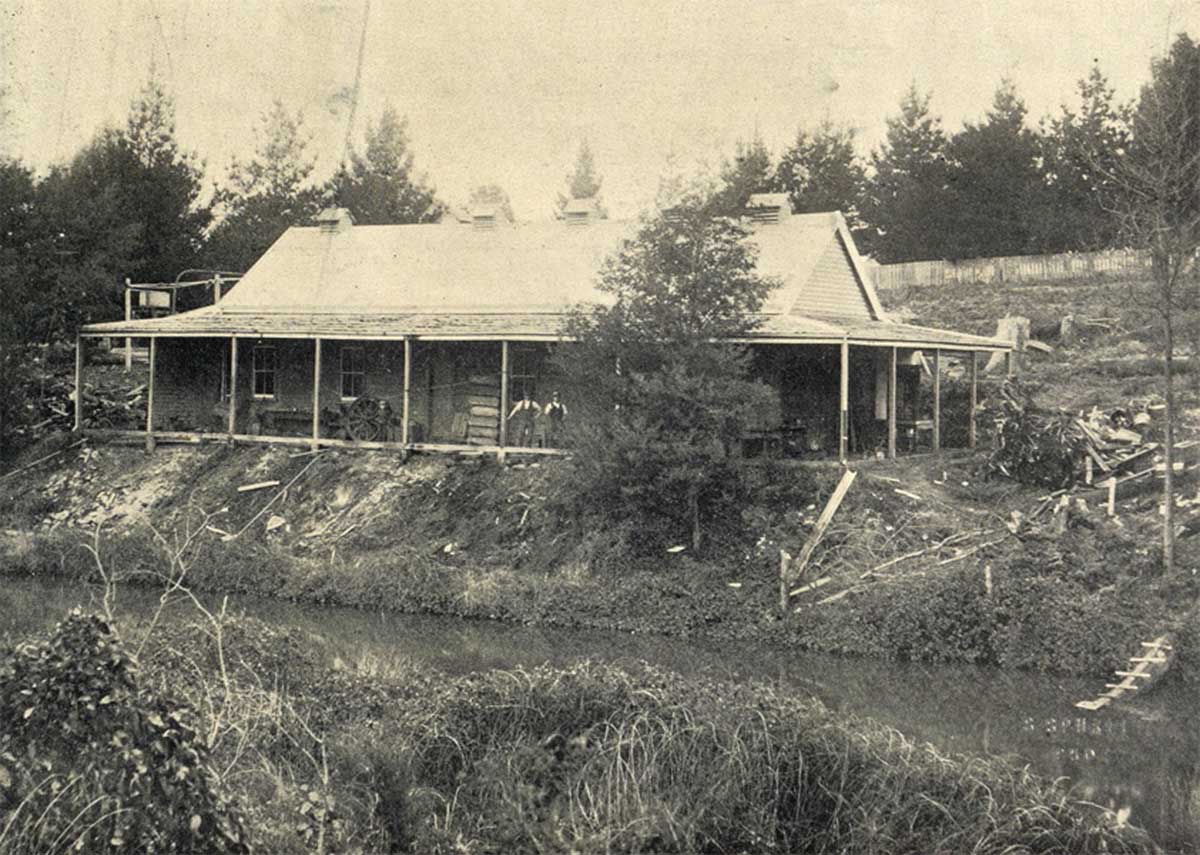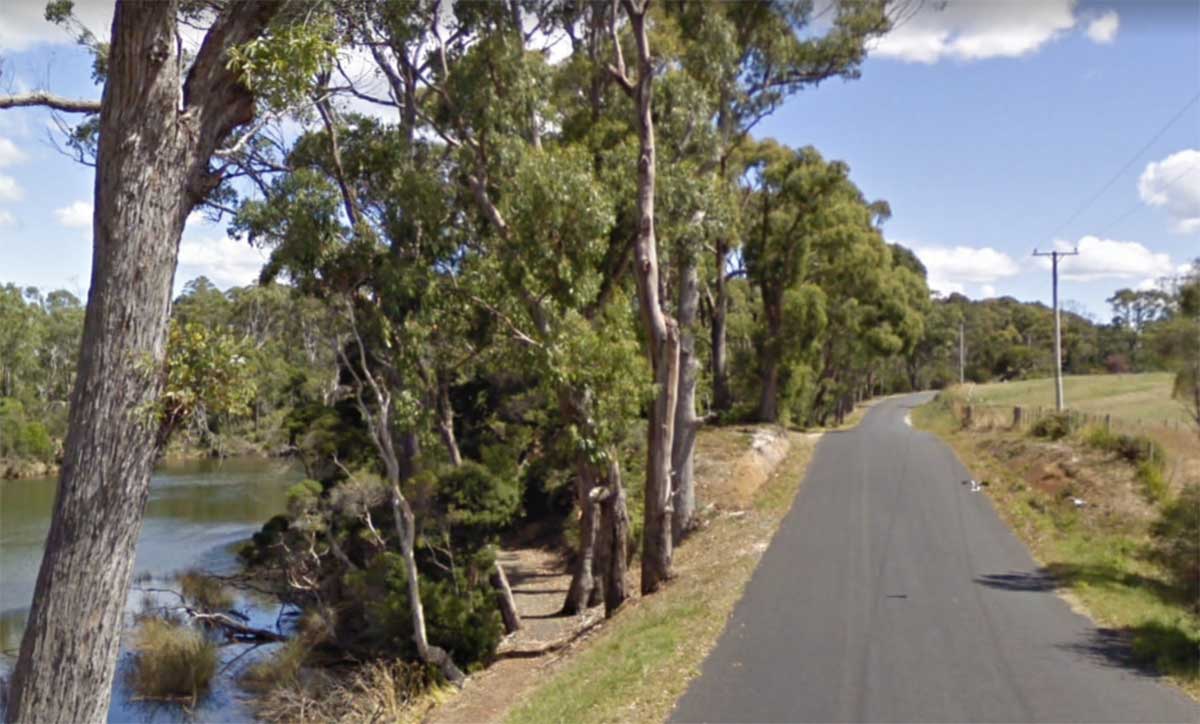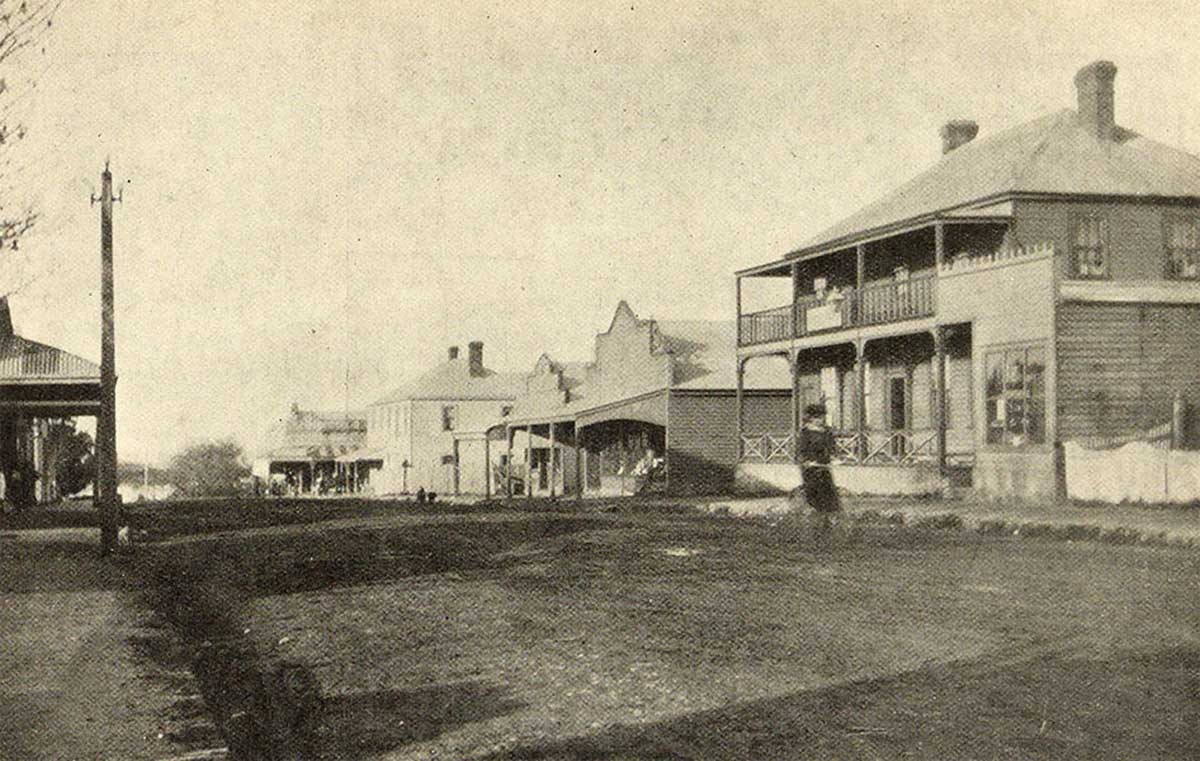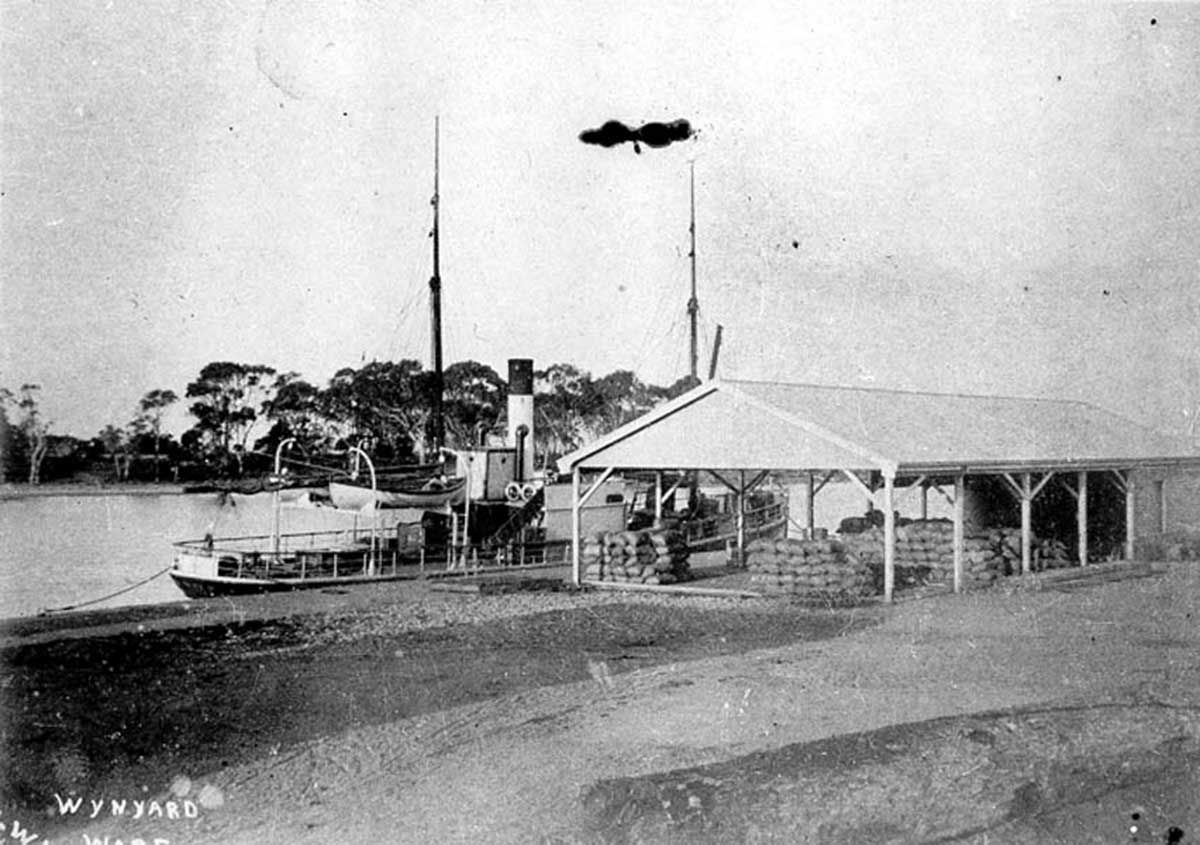Wynyard History

Wynyard in 1912, showing the Post Office under construction
In 1798 George Bass and Matthew Flinders sailed in their sloop 'Norfolk" through Bass Strait, and named the large promontory near the mouth of the Inglis River 'Table Cape', which is now a well-known, local landmark. Back then, the cape had trees up to 12 metres in diameter at the base; the area was stripped of these huge stringybark eucalyptus gum trees in the late 19th century by timber cutters. When European settlement began, the beautiful red loam of the Cape was recognised as perfectly suited to the growing of potatoes, peas, onions and corn and the raising of sheep and cattle; more recently it has changed to the cultivation of poppies, pyrethrum and tulips.
Wynyard sits in the shelter of Table Cape, right in the middle of a huge track of land that the Van Diemen's Land Co. gained the rights to develop under its Royal Charter of 1824. The charter gave it the right to cultivate land, build roads and bridges, lend money to colonists, execute public works, and build and buy houses, wharves and other buildings. They were granted six parcels of land in the north-west of the colony, eventually amounting to over 350,000 acres, which includes the site of the town of Wynyard and its environs.

Map of Tasmania, 1822
Edward Curr was appointed the chief agent of the Company in Van Diemen’s Land and led a group of English officials to Van Diemens Land, arriving in Hobart in March 1826 to begin establishing the Company - chief agent Eward Curr, Stephen Adey (superintendent), Alexander Goldie (agriculturalist), Henry Hellyer (surveyor and architect), Joseph Fossey and Clement Lorymer (surveyors). They travelled north and selected land at Circular Head, the Surrey and Hampshire Hills to the south of Burnie, and Woolnorth on Cape Grim. The Company established its base at Highfield House at Circular Headand in 1829 began renting land to tenants.
In the winter of 1826, Curr depatched the company's agricultural adviser, Alexander Goldie, and surveyor Joseph Fossey in a whaleboat from their camp at North Down (Port Sorell) to examine the coastline and its rivers from Port Sorell to Cape Grim for the company. During the voyage, their party explored the Inglis River on the banks of which the town of Wynyard would eventually be built.

Part of the reason for the expedition was to find a suitable location for a port through which the company's anticipated future bounty could be exported. The chief surveyor Henry Hellyer conducted a similar journey, but inland, in serach of land suitable for grazing sheep. He had returned via the coast and returned convinced that Emu Bay, the site of present day Burnie, was the most suitable location. Curr favoured Table Bay (the site of present day Wynyard) and to assist him in making the decision, Curr engaged the services of George Barnard, a retired Royal Navy Lietenand who had recently surveyed King Island for Gov. George Arthur. Hellyer, Curr and Barnard left Circuler Head in a whaleboat on 26th September 1827 - Curr and Hellyer walked inland from Emu Bay while Barnard continued his coastal survey. Barnard's recommendation was Table Bay. In spite of Barnard's conclusion, Hellyer pushed ahead with his choice, and within a short time, the whole idea of a port at Table Bay was forgotten.
John King, a farm overseer from Farnborough, Yorkshire, who was engaged by the VDL Co. in 1831 as farm superintendent, arrived at Circular Head in April 1832 aboard the 'Forth' with his family and 18 other indentured servants and their families whose name would become synonymous with the early days of the North-West's european history. These included John and Thomas Neal, shepherds; John Cross, stonemason and bricklayer, all from Mixbury, Oxfordshire; John Dowling, a single man who was accompanied by his sheepdog, which proved to be invaluable asset.

Table Cape butter factory
Table Cape
John King became superintendent of Highfield Estate (Stanley), Cross and Neal absconded with other indented servants. King and Curr were at loggerheads from the day they first met, and it was jo surprise that King left the company's employ to establish a farm on Table Cape the day his seven year contract expired. King had become aware of the Table Cape area's rich, red volcanic soil and its suitability for agriculure, and was highly qualified to pioneer the Inglis River area. John King was only the second pioneer to select crown land on the North-west coast after John Fenton at Forth. Fenton visited King'a isolated from in December 1843, and wrote about it in his book, Bush Life in Tasmania. Fenton praised King for his success, but that success would be short-lived. John king drowned in the Cam River in January 1845 on his way back from Launceston and Emu Bay. His widow sold the property to James Percy.
Like most of the VDl Co.'s indentired servants, John Dowling was deparately unhappy. Initially, he was at Circular Head and then at Surrey Hills (south of Burnie) before absconding in Sptember, 1832. He gained farm employment near Launceston and by 1851 had enough capital to buy the Brisbane Hotel, Launceston. In 1855 when potatoes were fetching £20 a ton, he bought 100 acres of prime farmland on Table Cape from John Alexander. The pair had been neighbours in Wiltshire and John Dowling renewed acquaintances with John and his brothers Matthias and Joseph when they established the first settlement on the Inglis River in the early 1850s.
Dowling, who had arrived in the colony as a 24 year old farm servant with his faithful sheepdog, soon became one of the biggest landowners in the Wynyard district, with freehold farms at Table Cape, Mt Hicks and Boat Harbour and the lease of henrietta plains for grazing cattle. He married twice, and fathered 21 children, many of whom farmed the Wynyard district.

The Inglis River near the site of Alexandria today
Alexandria
Brothers Joseph and Matthias Alexander were transported to Van Diemen's Land in 1831 for taking part in the widespread Wiltshire Swill Rebellion in England's rural districts. It is said that their younger brother, John, who missed out on being arrested and transported, stole a few pigs so that he could also join his brothers in Van Diemen's Land. He was reunited with them in Hobart early 1833. By 1836, Joseph and Matthais had been pardoned and found work at Wickford Estate near Lomgford. John received his certificate of freedom in the same year, but chose to seek his fortune on the Californian goldfields. He then returned to Australia, joining the Ballarat gold rush. Luck was with him, and he found enough gold to return to his brothers in Australia and invest in land.

Trading vessel, 1860s
Meanwhile, the brothers met up again, pooled their resorces, and bought land on Table Cape. At this time, the town of Melbourne - across Bass Strait on the Australian mainland - was developing fast and as a result, experienced an acute shortage of suitable timber for building. Like James Fenton, who would soon purchase land on the Forth River for the same purpose, the Alexanders were aware that the forests of the North-West were an ideal source of the kind of timber Melbourne needed, and decided to take up some land on the east side of the Inglis River with the intent of harvesting the timber on and around the cape and exporting it direct to Melbourne from their base on the Inglis River. To that end, they built an inn and a jetty, and acquired several small ships. The brothers commissioned the first ship to be built on the Inglis River in 1851, and named it “The Alexander.” It was a small schooner used for produce and timber trading, and it was said to have been built about a mile up river of the present “Alexandria.”
Wthin a year, their settlement, known as Alexandia and populated mainly by the timber cutters they hired to clear the forests, boasted a general store, a draper's store, shoemarker's shop, and blacksmith and a jetty. Joseph Alexander built the first hotel (Table Cape Inn) here in 1852 and Matthias managed it until his death in 1865. John Alexander became by far the biggest landowner on the Cape. After establishing Alexandria with his brothers, he still had enough capital left to select 1,500 acres, which at that time was still heavily forested. He cleared it of timber and used the proceeds to purchase more land. By the mid 1870s, Martin, the youngest son of Matthias, had taken up the Table Cape property, cleared it and added to it. He owned almost all of the Cape plateau, and the southern sloped down to Freestone Cove.

Table Cape lighthouse was built during Martin's period of ownership. Martin had a contract with the builders to transport the bricks which came across as ship's ballast from Victoria up to the building site using the bullock drays he had built to move the giant stringy-bark eucalypts that once covered the Cape's tableland. The huge logs were hauled on the drays to the edge of the Cape, where they were rolled downhill into the sea. A dispute arose between Martin and the builders over bringing equipment across his private land, but was resolved with the builders agreeing to build a new road up to and cross his property, replacing a track Martin's father had cut up the hillside.
Wynyard
Shortly after the establishment of Alexandia, development of the land on the east side of the river began. A small town was laid out, and it grew rapidly. A store, a wharf, a timber mill, a hotel, a blacksmith's store and a tramway were all built in quick succession, but even so, it lagged behind Alexandia for quite some time.

Goldie Street, Wynyard, 1909
The new town was known as Table Cape until the 1850s, when its name was changed to Wynyard. It is on record as having been named after a military man named Wynyard, but the question remains: which one? It is widely reported that it was Lieutenant-General Edward Buckley Wynyard (1788-1864), the commander of troops in New South Wales, who became lieutenant-general in 1851. Two years later, he left Sydney and returned to London, but not before visiting the infant settlement of Alexandria and surrunding districts in 1850-51.
But another contender for the honour of have the town named after him is New Zealand's Lieutenant Governor Robert Henry Wynyard. When his regiment was posted to Sydney, New South Wales, in 1844, Wynyard was sent on to New Zealand with 200 men to take part in the Flagstaff War against Hone Heke and Kawiti. From 26 April 1851 to 7 March 1853, Wynyard was Lieutenant-Governor of New Ulster, a province of New Zealand encompassing much of the North Island. Robert Henry Wynyard is known to have visited Tasmania, as he noted its topographic similarity to New Zealand.
Edward Buckley Wynyard, however, seems to be the more likey of the two to have the new settlement named after him. He visited the Table Cape district a
just a few months after the Government surveyor, Peter Lette, and his party had arrived to survey the crown lands from the Cam River to Boat Harbour occupied by lessees for purchase. Government records indicate that Wynyard may well have joined them on one or more of their surveys. He was still there when Lette began laying out the 500 acre town reserve of Wynyard, so there seems little doubt that he was the one Lette named the town after.

Loading potatoes at Wynyard wharf
Initially, the tiny township of Wynyard struggled for survival. In 1856, a pioneer settler of the town who moved away, recalled "Wynyard from 1953 to 1861 was a poor, miserable place, nearly the whole covered with scrub and good sized trees here and there, no roads except the roads made by the paling-carters, and perhaps seven houses all told. One of these was occupied by Surveyor Lette and another by the surveyor Simmons".
After the Inglis River was bridged in 1861, Alexandria began to fade and Wynyard, with its better wharfing, began to grow. It was declared a port in 1866, though by 1881, it was still one of the smaller settlements of the North-West coast, with a population of around 170. At that time, the total population from the Cam River to the Detention River was around 600. By the late 19th century, Wynyard had become the district's centre of commerce, handling more shipping than Burnie, its population reaching 500 by 1900.
Charles Benjamin Fonds Fenton, the son of pioneer settler and founder of Forth, James Fenton, bought land on Table Cape and at Flowerdale in 1880. He had been a timber merchant and storekeeper at Forth before venturing into the contracting of pulbic works including building the Wynyard to Circular Head road and the smithton tramway, and his business skills kept the local economy alive during the 1890s depression by establishing a farmer's co-operative. This led to the construction of the Table Cape Butter and Bacon Factory Ld.
In the 20th century, Burnie flourished with the coming of major heavy industry, and Wynyard largely stagnated, though employment was provided by a butter factory and and a Danish factory which began building windmills for wind-farms in the 1990s.

Wynyard, 1960s
